SKODA FABIA 2004 1.G / 6Y Owner's Manual
Manufacturer: SKODA, Model Year: 2004, Model line: FABIA, Model: SKODA FABIA 2004 1.G / 6YPages: 247
Page 141 of 247
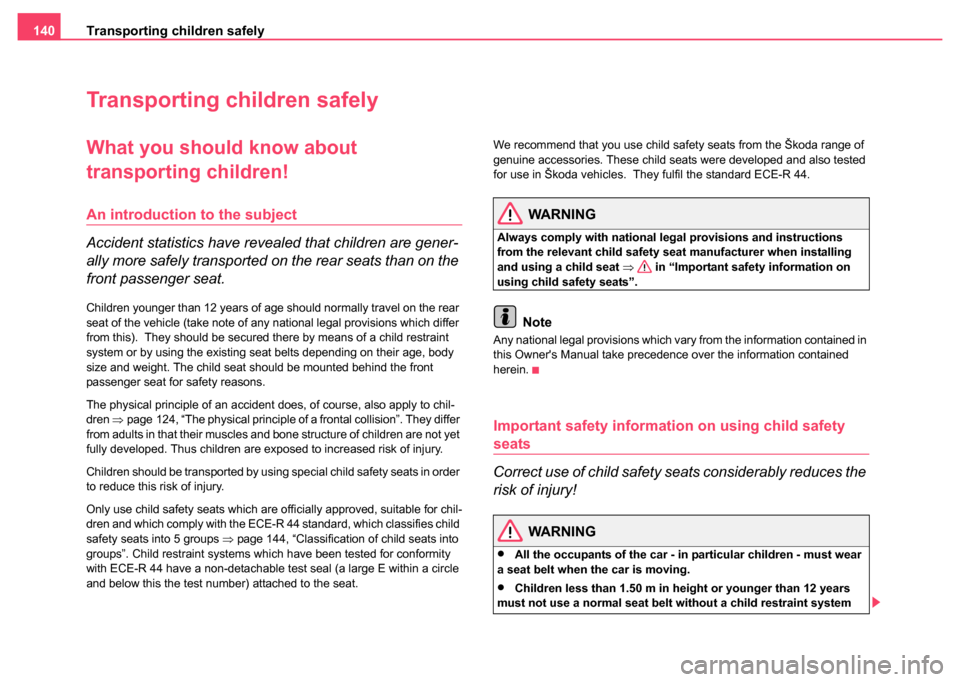
Transporting children safely
140
Transporting children safely
What you should know about
transporting children!
An introduction to the subject
Accident statistics have revealed that children are gener-
ally more safely transported on the rear seats than on the
front passenger seat.
Children younger than 12 years of age should normally travel on the rear
seat of the vehicle (take note of any national legal provisions which differ
from this). They should be secured there by means of a child restraint
system or by using the existing seat belts depending on their age, body
size and weight. The child seat should be mounted behind the front
passenger seat for safety reasons.
The physical principle of an accident does, of course, also apply to chil-
dren ⇒page 124, “The physical principle of a frontal collision”. They differ
from adults in that their muscles and bone structure of children are not yet
fully developed. Thus children are exposed to increased risk of injury.
Children should be transported by using special child safety seats in order
to reduce this risk of injury.
Only use child safety seats which are officially approved, suitable for chil-
dren and which comply with the ECE-R 44 standard, which classifies child
safety seats into 5 groups ⇒page 144, “Classification of child seats into
groups”. Child restraint systems which have been tested for conformity
with ECE-R 44 have a non-detachable test seal (a large E within a circle
and below this the test number) attached to the seat. We recommend that you use child safety seats from the Škoda range of
genuine accessories. These child seats were developed and also tested
for use in Škoda vehicles. They fulfil the standard ECE-R 44.
WARNING
Always comply with national le
gal provisions and instructions
from the relevant child safety seat manufacturer when installing
and using a child seat ⇒ in “Important safety information on
using child safety seats”.
Note
Any national legal provisions which vary from the information contained in
this Owner's Manual take precedence over the information contained
herein.
Important safety informati on on using child safety
seats
Correct use of child safety seats considerably reduces the
risk of injury!
WARNING
•All the occupants of the car - in particular children - must wear
a seat belt when the car is moving.
•Children less than 1.50 m in height or younger than 12 years
must not use a normal seat belt without a child restraint system
Page 142 of 247
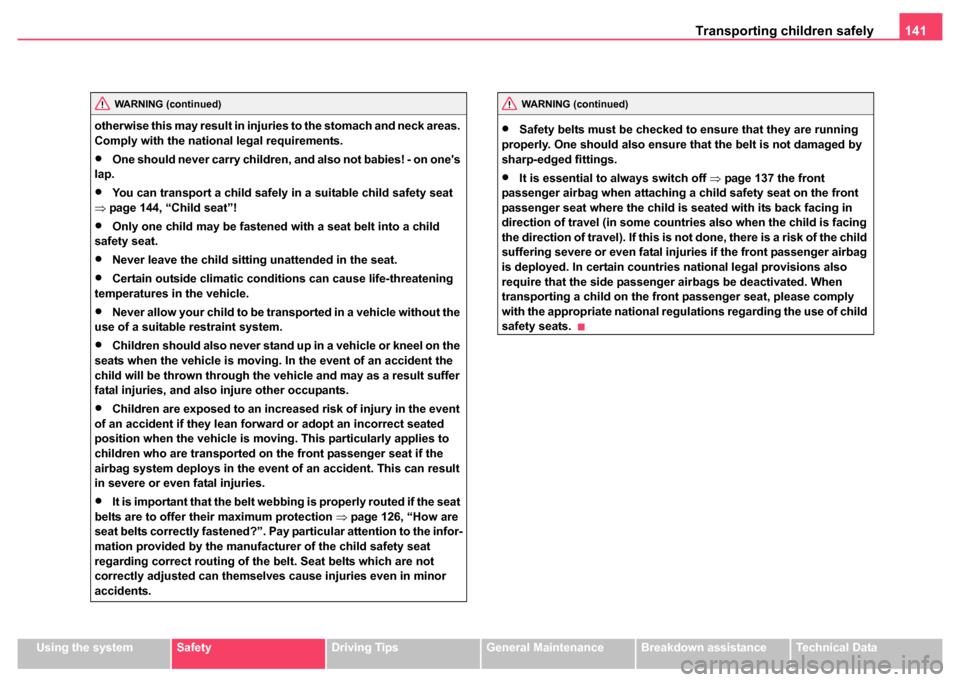
Transporting children safely 141
Using the systemSafetyDriving TipsGeneral MaintenanceBreakdown assistanceTechnical Data
otherwise this may result in injuries to the stomach and neck areas.
Comply with the national legal requirements.
•One should never carry children, and also not babies! - on one's
lap.
•You can transport a child safely in a suitable child safety seat
⇒ page 144, “Child seat”!
•Only one child may be fastened with a seat belt into a child
safety seat.
•Never leave the child sitting unattended in the seat.
•Certain outside climatic conditions can cause life-threatening
temperatures in the vehicle.
•Never allow your child to be transported in a vehicle without the
use of a suitable restraint system.
•Children should also never stand up in a vehicle or kneel on the
seats when the vehicle is moving. In the event of an accident the
child will be thrown through the vehicle and may as a result suffer
fatal injuries, and also injure other occupants.
•Children are exposed to an increased risk of injury in the event
of an accident if they lean forward or adopt an incorrect seated
position when the vehicle is moving . This particularly applies to
children who are transported on the front passenger seat if the
airbag system deploys in the event of an accident. This can result
in severe or even fatal injuries.
•It is important that the belt webb ing is properly routed if the seat
belts are to offer their maximum protection ⇒page 126, “How are
seat belts correctly fastened?”. Pay particular attention to the infor-
mation provided by the manufacturer of the child safety seat
regarding correct routing of the belt. Seat belts which are not
correctly adjusted can themselves cause injuries even in minor
accidents.
•Safety belts must be checked to ensure that they are running
properly. One should also ensure that the belt is not damaged by
sharp-edged fittings.
•It is essential to always switch off ⇒page 137 the front
passenger airbag when attaching a child safety seat on the front
passenger seat where the child is seated with its back facing in
direction of travel (in some countries also when the child is facing
the direction of travel). If this is not done, there is a risk of the child
suffering severe or even fatal injuries if the front passenger airbag
is deployed. In certain countries national legal provisions also
require that the side passenger airbags be deactivated. When
transporting a child on the front passenger seat, please comply
with the appropriate national regul ations regarding the use of child
safety seats.
WARNING (continued)WARNING (continued)
Page 143 of 247
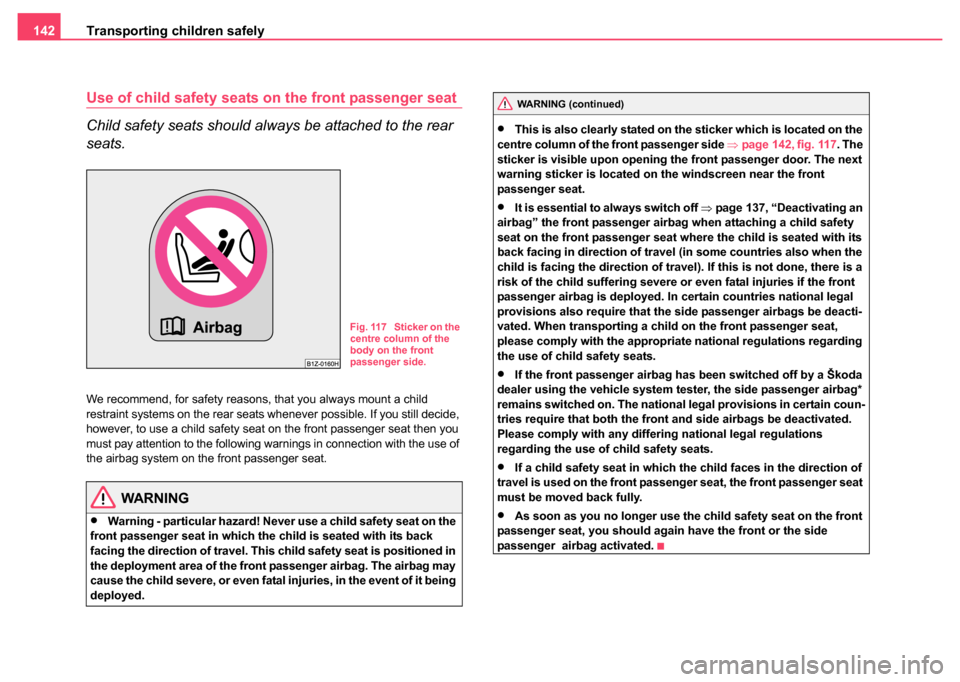
Transporting children safely
142
Use of child safety seats on the front passenger seat
Child safety seats should always be attached to the rear
seats.
We recommend, for safety reasons, that you always mount a child
restraint systems on the rear seats whenever possible. If you still decide,
however, to use a child safety seat on the front passenger seat then you
must pay attention to the following warnings in connection with the use of
the airbag system on the front passenger seat.
WARNING
•Warning - particular hazard! Never use a child safety seat on the
front passenger seat in which the child is seated with its back
facing the direction of travel. This child safety seat is positioned in
the deployment area of the front passenger airbag. The airbag may
cause the child severe, or even fatal injuries, in the event of it being
deployed.
•This is also clearly stated on the sticker which is located on the
centre column of the front passenger side ⇒page 142, fig. 117 . The
sticker is visible upon opening the front passenger door. The next
warning sticker is located on the windscreen near the front
passenger seat.
•It is essential to always switch off ⇒ page 137, “Deactivating an
airbag” the front passenger airbag when attaching a child safety
seat on the front passenger seat where the child is seated with its
back facing in direction of travel (in some countries also when the
child is facing the direction of travel). If this is not done, there is a
risk of the child suffering severe or even fatal injuries if the front
passenger airbag is deployed. In certain countries national legal
provisions also require that the side passenger airbags be deacti-
vated. When transporting a child on the front passenger seat,
please comply with the appropriat e national regulations regarding
the use of child safety seats.
•If the front passenger airbag has been switched off by a Škoda
dealer using the vehicle system tester, the side passenger airbag*
remains switched on. The national legal provisions in certain coun-
tries require that both the front and side airbags be deactivated.
Please comply with any differ ing national legal regulations
regarding the use of child safety seats.
•If a child safety seat in which the child faces in the direction of
travel is used on the front passenger seat, the front passenger seat
must be moved back fully.
•As soon as you no longer use the child safety seat on the front
passenger seat, you should again have the front or the side
passenger airbag activated.
Fig. 117 Sticker on the
centre column of the
body on the front
passenger side.
WARNING (continued)
Page 144 of 247
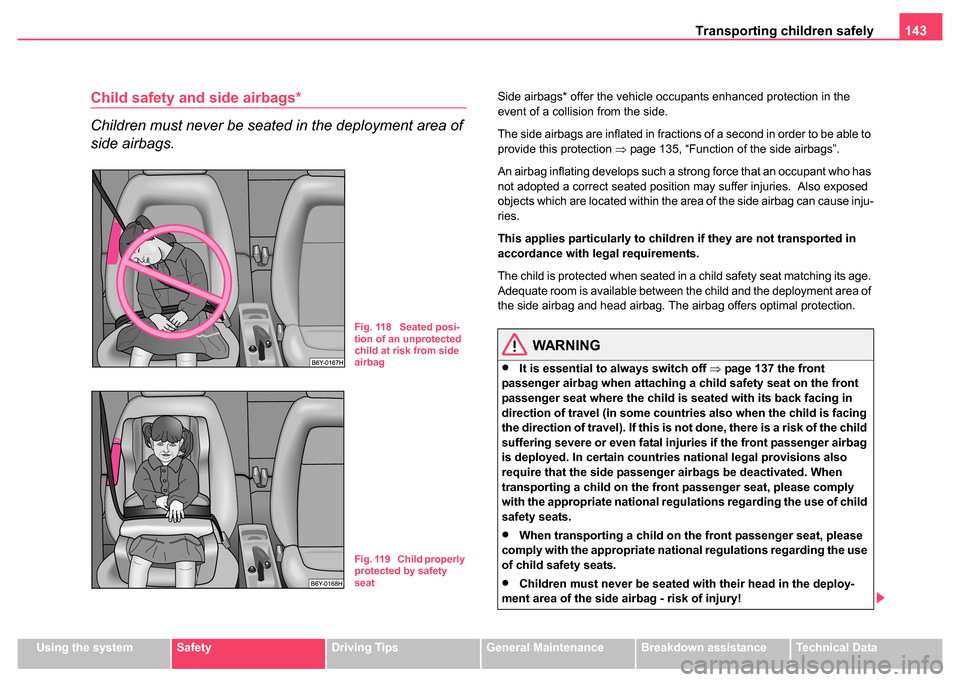
Transporting children safely 143
Using the systemSafetyDriving TipsGeneral MaintenanceBreakdown assistanceTechnical Data
Child safety and side airbags*
Children must never be seated in the deployment area of
side airbags.Side airbags* offer the vehicle occupants enhanced protection in the
event of a collision from the side.
The side airbags are inflated in fractions of a second in order to be able to
provide this protection ⇒page 135, “Function of the side airbags”.
An airbag inflating develops such a strong force that an occupant who has
not adopted a correct seated position may suffer injuries. Also exposed
objects which are located within the area of the side airbag can cause inju-
ries.
This applies particularly to children if they are not transported in
accordance with legal requirements.
The child is protected when seated in a child safety seat matching its age.
Adequate room is available between the child and the deployment area of
the side airbag and head airbag. The airbag offers optimal protection.
WARNING
•It is essential to always switch off ⇒page 137 the front
passenger airbag when attaching a child safety seat on the front
passenger seat where the child is seated with its back facing in
direction of travel (in some countries also when the child is facing
the direction of travel). If this is not done, there is a risk of the child
suffering severe or even fatal injuries if the front passenger airbag
is deployed. In certain countries national legal provisions also
require that the side passenger airbags be deactivated. When
transporting a child on the front passenger seat, please comply
with the appropriate national regul ations regarding the use of child
safety seats.
•When transporting a child on the front passenger seat, please
comply with the appropriate national regulations regarding the use
of child safety seats.
•Children must never be seated with their head in the deploy-
ment area of the side airbag - risk of injury!
Fig. 118 Seated posi-
tion of an unprotected
child at risk from side
airbag
Fig. 119 Child properly
protected by safety
seat
Page 145 of 247
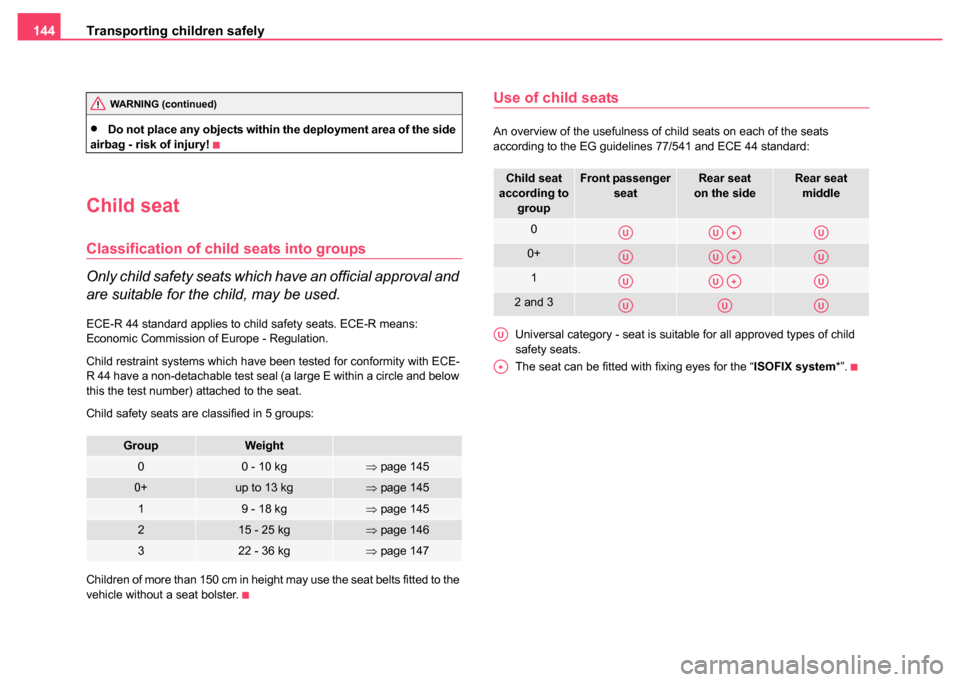
Transporting children safely
144
•Do not place any objects within the deployment area of the side
airbag - risk of injury!
Child seat
Classification of child seats into groups
Only child safety seats which have an official approval and
are suitable for the child, may be used.
ECE-R 44 standard applies to child safety seats. ECE-R means:
Economic Commission of Europe - Regulation.
Child restraint systems which have been tested for conformity with ECE-
R 44 have a non-detachable test seal (a large E within a circle and below
this the test number) attached to the seat.
Child safety seats are classified in 5 groups:
Children of more than 150 cm in height may use the seat belts fitted to the
vehicle without a seat bolster.
Use of child seats
An overview of the usefulness of child seats on each of the seats
according to the EG guidelines 77/541 and ECE 44 standard:
Universal category - seat is suitable for all approved types of child
safety seats.
The seat can be fitted with fixing eyes for the “ISOFIX system *”.
GroupWeight
00 - 10 kg⇒page 145
0+up to 13 kg⇒page 145
19 - 18 kg⇒page 145
215 - 25 kg⇒page 146
322 - 36 kg⇒page 147
WARNING (continued)
Child seat
according to groupFront passenger
seatRear seat
on the sideRear seat middle
0
0+
1
2 and 3
AUAUA+AU
AUAUA+AU
AUAUA+AU
AUAUAU
AU
A+
Page 146 of 247
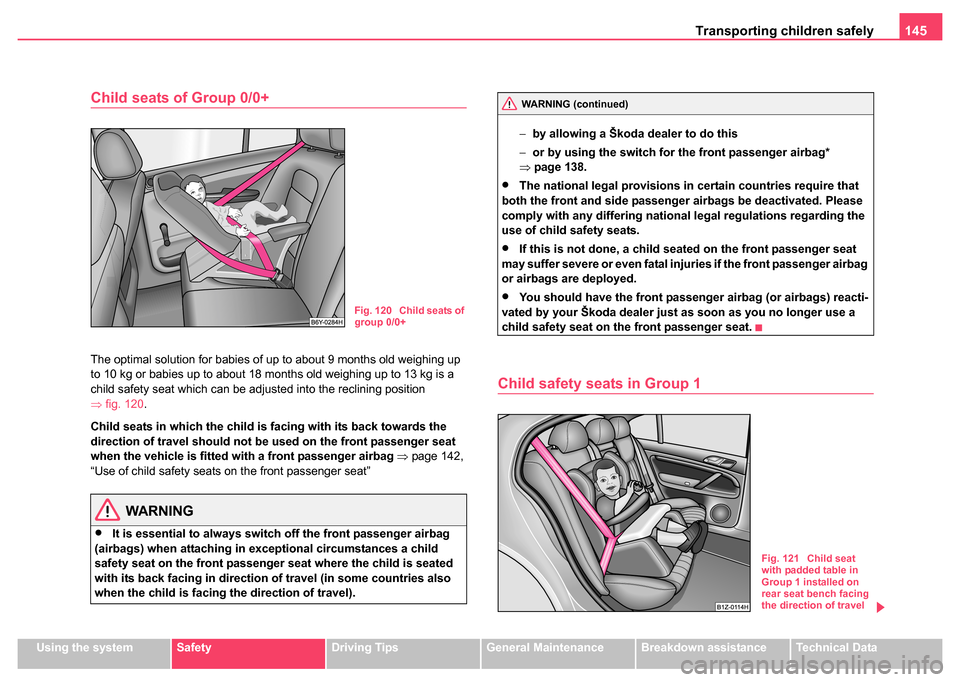
Transporting children safely 145
Using the systemSafetyDriving TipsGeneral MaintenanceBreakdown assistanceTechnical Data
Child seats of Group 0/0+
The optimal solution for babies of up to about 9 months old weighing up
to 10 kg or babies up to about 18 months old weighing up to 13 kg is a
child safety seat which can be adjusted into the reclining position
⇒fig. 120 .
Child seats in which the child is facing with its back towards the
direction of travel should not be used on the front passenger seat
when the vehicle is fitted with a front passenger airbag ⇒ page 142,
“Use of child safety seats on the front passenger seat”
WARNING
•It is essential to always switch off the front passenger airbag
(airbags) when attaching in exceptional circumstances a child
safety seat on the front passenger seat where the child is seated
with its back facing in direction of travel (in some countries also
when the child is facing the direction of travel). −
by allowing a Škoda dealer to do this
− or by using the switch for the front passenger airbag*
⇒ page 138.
•The national legal provisions in certain countries require that
both the front and side passenger airbags be deactivated. Please
comply with any differing national legal regulations regarding the
use of child safety seats.
•If this is not done, a child seated on the front passenger seat
may suffer severe or even fatal injuries if the front passenger airbag
or airbags are deployed.
•You should have the front passenger airbag (or airbags) reacti-
vated by your Škoda dealer just as soon as you no longer use a
child safety seat on the front passenger seat.
Child safety seats in Group 1
Fig. 120 Child seats of
group 0/0+
WARNING (continued)
Fig. 121 Child seat
with padded table in
Group 1 installed on
rear seat bench facing
the direction of travel
Page 147 of 247
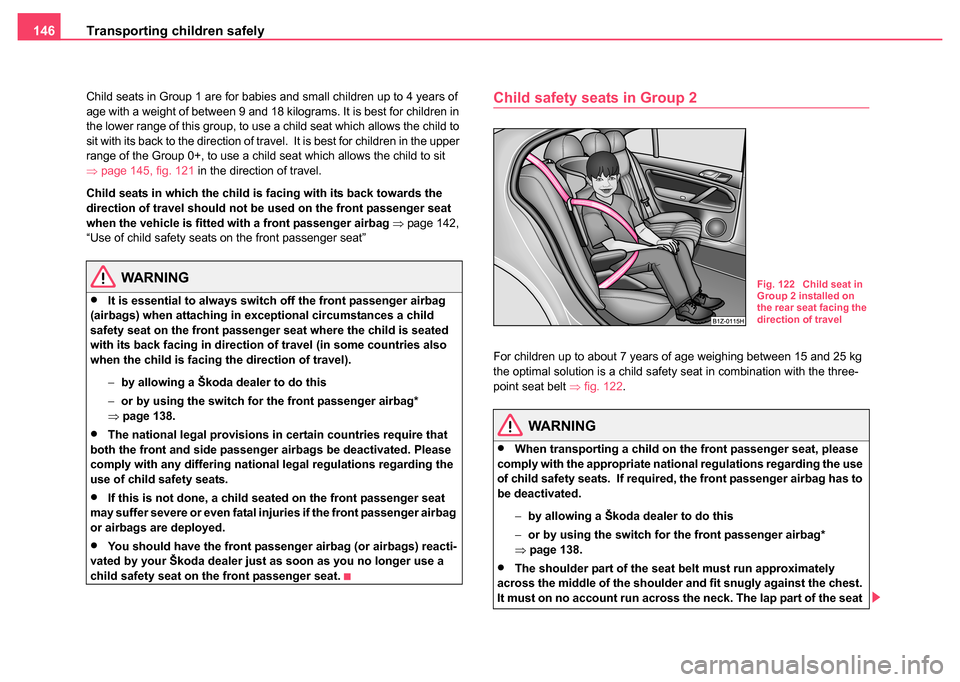
Transporting children safely
146
Child seats in Group 1 are for babies and small children up to 4 years of
age with a weight of between 9 and 18 kilograms. It is best for children in
the lower range of this group, to use a child seat which allows the child to
sit with its back to the direction of travel. It is best for children in the upper
range of the Group 0+, to use a child seat which allows the child to sit
⇒ page 145, fig. 121 in the direction of travel.
Child seats in which th e child is facing with its back towards the
direction of travel should not be used on the front passenger seat
when the vehicle is fitted with a front passenger airbag ⇒ page 142,
“Use of child safety seats on the front passenger seat”
WARNING
•It is essential to always switch off the front passenger airbag
(airbags) when attaching in exceptional circumstances a child
safety seat on the front passenger seat where the child is seated
with its back facing in direction of travel (in some countries also
when the child is facing the direction of travel).
−by allowing a Škoda dealer to do this
− or by using the switch for the front passenger airbag*
⇒ page 138.
•The national legal provisions in certain countries require that
both the front and side passenger airbags be deactivated. Please
comply with any differing nationa l legal regulations regarding the
use of child safety seats.
•If this is not done, a child seated on the front passenger seat
may suffer severe or even fatal injuries if the front passenger airbag
or airbags are deployed.
•You should have the front passenger airbag (or airbags) reacti-
vated by your Škoda dealer just as soon as you no longer use a
child safety seat on the front passenger seat.
Child safety seats in Group 2
For children up to about 7 years of age weighing between 15 and 25 kg
the optimal solution is a child safety seat in combination with the three-
point seat belt ⇒fig. 122 .
WARNING
•When transporting a child on the front passenger seat, please
comply with the appropriate national regulations regarding the use
of child safety seats. If required, the front passenger airbag has to
be deactivated.
−by allowing a Škoda dealer to do this
− or by using the switch for the front passenger airbag*
⇒ page 138.
•The shoulder part of the seat belt must run approximately
across the middle of the shoulder and fit snugly against the chest.
It must on no account run across the neck. The lap part of the seat
Fig. 122 Child seat in
Group 2 installed on
the rear seat facing the
direction of travel
Page 148 of 247
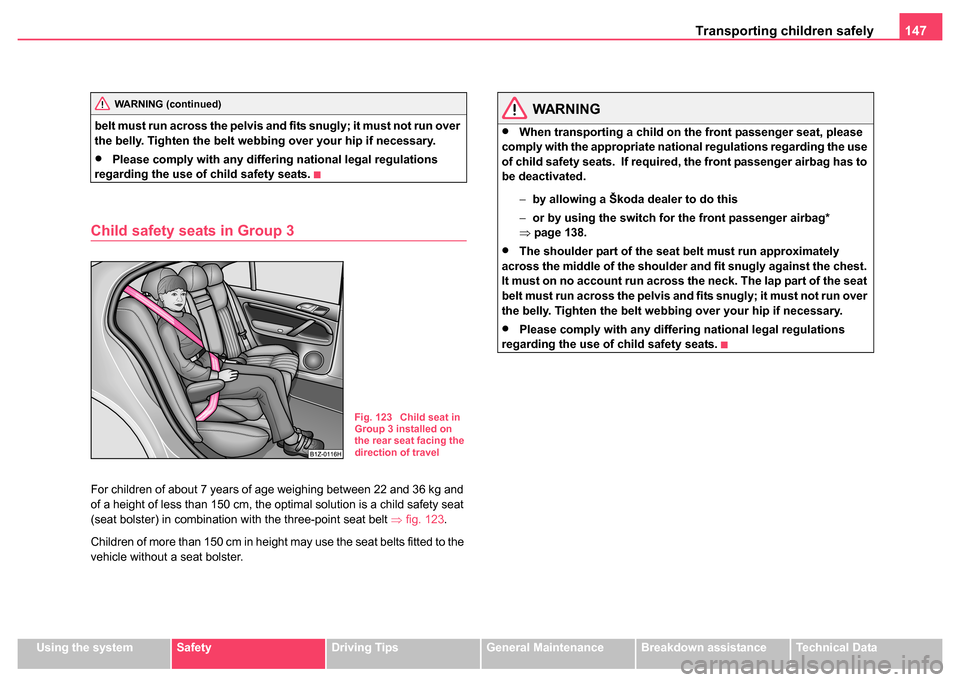
Transporting children safely 147
Using the systemSafetyDriving TipsGeneral MaintenanceBreakdown assistanceTechnical Data
belt must run across the pelvis and fits snugly; it must not run over
the belly. Tighten the belt webbing over your hip if necessary.
•Please comply with any differin
g national legal regulations
regarding the use of child safety seats.
Child safety seats in Group 3
For children of about 7 years of age weighing between 22 and 36 kg and
of a height of less than 150 cm, the optimal solution is a child safety seat
(seat bolster) in combination with the three-point seat belt ⇒fig. 123 .
Children of more than 150 cm in height may use the seat belts fitted to the
vehicle without a seat bolster.
WARNING
•When transporting a child on the front passenger seat, please
comply with the appropriate national regulations regarding the use
of child safety seats. If required, the front passenger airbag has to
be deactivated.
−by allowing a Škoda dealer to do this
− or by using the switch for the front passenger airbag*
⇒ page 138.
•The shoulder part of the seat belt must run approximately
across the middle of the shoulder and fit snugly against the chest.
It must on no account run across the neck. The lap part of the seat
belt must run across the pelvis and fits snugly; it must not run over
the belly. Tighten the belt webbing over your hip if necessary.
•Please comply with any differ ing national legal regulations
regarding the use of child safety seats.
WARNING (continued)
Fig. 123 Child seat in
Group 3 installed on
the rear seat facing the
direction of travel
Page 149 of 247
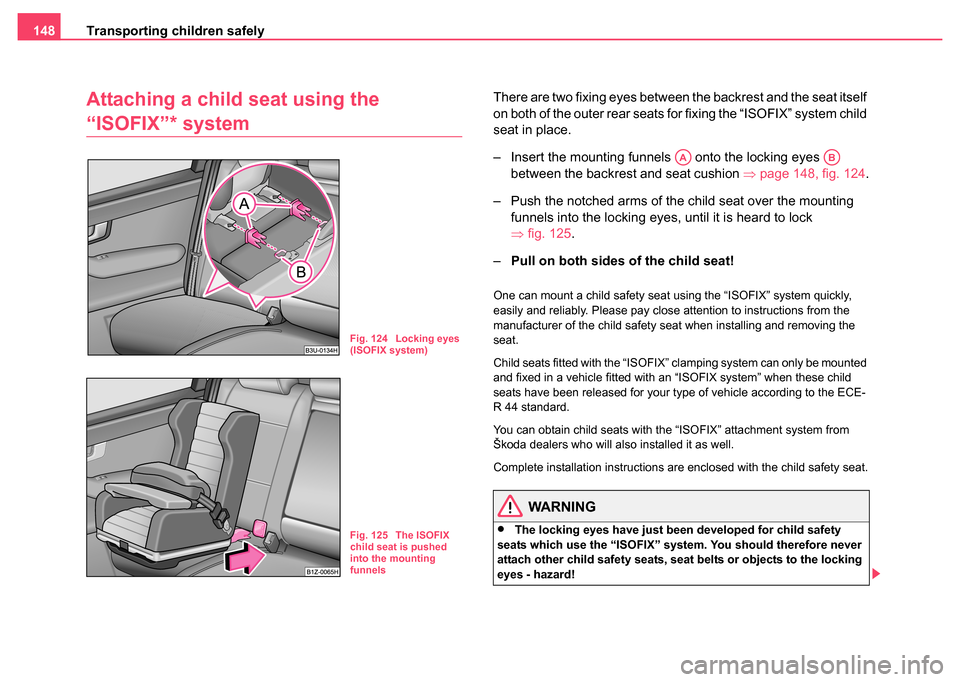
Transporting children safely
148
Attaching a child seat using the
“ISOFIX”* system
There are two fixing eyes between the backrest and the seat itself
on both of the outer rear seats for fixing the “ISOFIX” system child
seat in place.
– Insert the mounting funnels onto the locking eyes
between the backrest and seat cushion ⇒page 148, fig. 124.
– Push the notched arms of the child seat over the mounting funnels into the locking eyes, until it is heard to lock
⇒fig. 125 .
– Pull on both sides of the child seat!
One can mount a child safety seat using the “ISOFIX” system quickly,
easily and reliably. Please pay close attention to instructions from the
manufacturer of the child safety seat when installing and removing the
seat.
Child seats fitted with the “ISOFIX” clamping system can only be mounted
and fixed in a vehicle fitted with an “ISOFIX system” when these child
seats have been released for your type of vehicle according to the ECE-
R 44 standard.
You can obtain child seats with the “ISOFIX” attachment system from
Škoda dealers who will also installed it as well.
Complete installation instructions are enclosed with the child safety seat.
WARNING
•The locking eyes have just been developed for child safety
seats which use the “ISOFIX” system. You should therefore never
attach other child safety seats, seat belts or objects to the locking
eyes - hazard!
Fig. 124 Locking eyes
(ISOFIX system)
Fig. 125 The ISOFIX
child seat is pushed
into the mounting
funnels
AAAB
Page 150 of 247
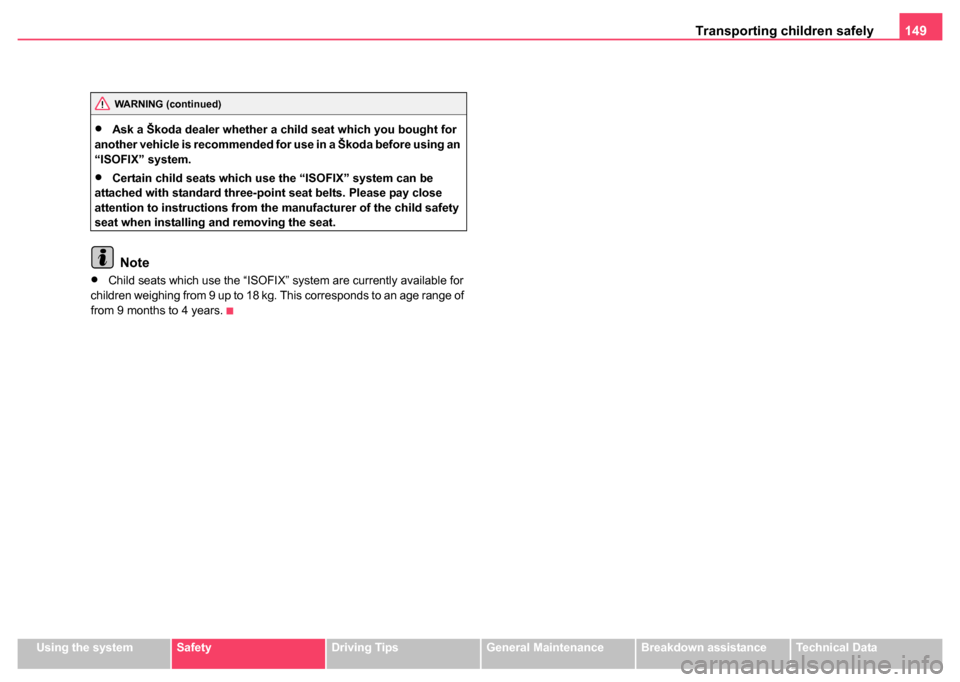
Transporting children safely 149
Using the systemSafetyDriving TipsGeneral MaintenanceBreakdown assistanceTechnical Data
•Ask a Škoda dealer whether a child seat which you bought for
another vehicle is recommended for use in a Škoda before using an
“ISOFIX” system.
•Certain child seats which use the “ISOFIX” system can be
attached with standard three-point seat belts. Please pay close
attention to instructions from the manufacturer of the child safety
seat when installing and removing the seat.
Note
•Child seats which use the “ISOFIX” system are currently available for
children weighing from 9 up to 18 kg. This corresponds to an age range of
from 9 months to 4 years.
WARNING (continued)